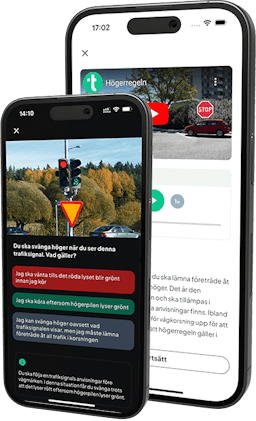Basic Rules
The road is a complicated environment where misunderstandings and accidents can easily occur. There is constant interplay going on between road users out on the roads. In order for this interplay to work, there are a number of different rules and signs along the roads. These are all based around a set of basic rules, which are:
- Show care and consideration.
- Do not disturb or obstruct others unnecessarily.
- Be considerate towards those on the roads and those who live close by.
- Be extra considerate towards children, the disabled and the elderly.
In summary, the basic rules describe what sort of environment should prevail on the roads.
One example of how you can follow the basic rules is not to use your horn in situations where it is not necessary to do so. You should only use your horn when it is necessary in order to prevent danger.

Defensive Driving
In order for this interplay on the roads to work properly, it is important that you plan your driving and that you drive in a clear and safe way. This is called defensive driving. If you drive defensively, then you will experience a lower degree of difficulty when driving and you will reduce the risk of surprising other road users or being surprised yourself.
How to apply defensive driving
- Plan your driving and leave yourself plenty of time.
- Drive smoothly and brake in good time.
- Stay one step ahead.
- Do not take any unnecessary risks.
- Make sure you have good visibility both in front and behind.
- Maintain good safety margins.
Adapt your Speed
One of the main causes of accidents is driving at too fast a speed. In order to avoid accidents on the road, it is important that you adapt your speed to the conditions you are driving in. When deciding what speed is appropriate, you should take the traffic condition, road condition, vehicle condition, vehicle load and visibility conditions into consideration.
The risk of having an accident can be particularly high in certain places and under certain conditions, and you are responsible for ensuring you maintain a sufficiently low speed.
For example:
- At sharp bends.
- At places where an accident has occurred or where road-works are being undertaken.
- In slippery road conditions.
- At pedestrian crossings.
- When visibility is reduced due to darkness.
- In built-up areas.
It can sometimes be difficult to know what speed limit applies in places where there are no signs; in such cases, you should follow the general speed limits:
- In built-up areas (A): 50 km/h.
- Outside built-up areas (B): 70 km/h.

Traffic Terms
The road is divided into three parts:
- The carriageway is the part of the road intended for vehicle traffic, but not including bike paths or hard shoulders.
- Lanes are the longitudinal stretches which are normally indicated by road markings. If there are no road markings, then the stretch is counted as a lane if it is wide enough for a four-wheel vehicle. If the area is wide enough for two four-wheel vehicles, then it is counted as two lanes, even if there are no road markings.
- The hard shoulder is primarily a safety zone for pedestrians, cyclists, drivers of slow moving vehicles and mopeds, but it can also be used temporarily by other vehicles.

Solid Line
Generally speaking, you may not cross a solid line. None of the vehicle’s wheels may cross over the line. However, there are certain exceptions where it is permitted to cross the line:
- If it is necessary in order to pass an obstacle on the road.
- If there is not enough space at a junction for your vehicle.
- If it is necessary when driving to or from a property or similar.
- If there is a broken line directly to the right of the solid line.


